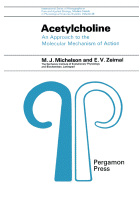Browse content
Table of contents
Actions for selected chapters
- Full text access
- Book chapterAbstract only
CHAPTER 1 - The Function of the Cholinergic Synapse
Pages 1-32 - Book chapterAbstract only
CHAPTER 2 - The Nature of Cholinoreceptors and Cholinesterases and Methods of Study of their Chemical Structure
Pages 33-44 - Book chapterAbstract only
CHAPTER 3 - The Quantitative Evaluation of the Action of Substances that Stimulate and Block the Cholinoreceptor
Pages 45-72a - Book chapterAbstract only
CHAPTER 4 - The Reactive Capacity of the Acetylcholine Molecule and the Structure of the Active Centres of Cholinoreceptors and Cholinesterases
Pages 73-123 - Book chapterAbstract only
CHAPTER 5 - Patterns of Arrangement of Individual Receptors on the Cholinoreceptive Membrane
Pages 125-159 - Book chapterAbstract only
CHAPTER 6 - Changes in the Pattern of Arrangement of Cholinoreceptors in the Process of Evolution
Pages 161-186 - Book chapterAbstract only
CHAPTER 7 - Non-Synaptic Cholinoreceptors
Pages 187-201 - Book chapterNo access
References
Pages 203-228 - Book chapterNo access
Author Index
Pages 229-235 - Book chapterNo access
Subject Index
Pages 237-241 - Book chapterNo access
Other Titles in the Division Modern Trends in Physiological Sciences
Page 243
About the book
Description
Acetylcholine: An Approach to the Molecular Mechanism of Action is an in-depth study of neurotransmitter system, with much focus on acetylcholine and its action and the cholinergic synapse. The book, divided into seven chapters, covers the following topics: the function of the cholinergic synapse; the movement of ions across membranes; the excitatory postsynaptic potential; the nature of cholinoreceptors and cholinesterases; the structure of its active centers; and the pattern of arrangement of the receptors of the cholinoreceptive membrane. The book also covers the quantitative evaluation of the action of neurotransmitters; the reactive capacity of the acetylcholine molecule and its effects on nerve endings and nerve fibers; and the release of mediators and hormones. The text is recommended for those who specialize in the fields of biology, medicine, biochemistry, and pharmacology, especially those wish to study about the neurotransmitter system, cholinoreceptors, the cholinergic synapse, the acetylcholine, and its action.
Acetylcholine: An Approach to the Molecular Mechanism of Action is an in-depth study of neurotransmitter system, with much focus on acetylcholine and its action and the cholinergic synapse. The book, divided into seven chapters, covers the following topics: the function of the cholinergic synapse; the movement of ions across membranes; the excitatory postsynaptic potential; the nature of cholinoreceptors and cholinesterases; the structure of its active centers; and the pattern of arrangement of the receptors of the cholinoreceptive membrane. The book also covers the quantitative evaluation of the action of neurotransmitters; the reactive capacity of the acetylcholine molecule and its effects on nerve endings and nerve fibers; and the release of mediators and hormones. The text is recommended for those who specialize in the fields of biology, medicine, biochemistry, and pharmacology, especially those wish to study about the neurotransmitter system, cholinoreceptors, the cholinergic synapse, the acetylcholine, and its action.
Details
ISBN
978-0-08-017159-3
Language
English
Published
1973
Copyright
Copyright © 1973 Elsevier Ltd. All rights reserved.
Imprint
Pergamon
